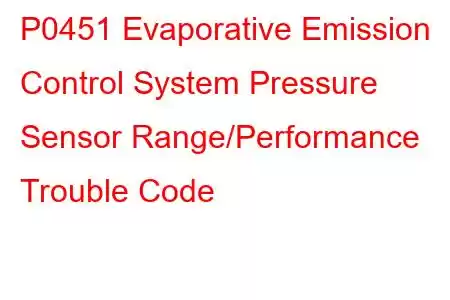P0451 Evap Emission System Pressure Sensor Performance
OBD-II Trouble Code Technical Description
Evaporative Emission Control System Pressure Sensor Range/Performance
What does that mean?
This diagnostic trouble code (DTC) is a generic powertrain code, which means that it applies to OBD-II equipped vehicles (Dodge, Ram, Ford, GMC, Chevrolet, VW, Audi, Toyota, etc.). Although generic, the specific repair steps may vary depending on make/model.
If your OBD-II vehicle has presented a code P0451, it simply means that the powertrain control module (PCM) has detected a malfunction in the pressure sensor circuit of the evaporative emissions (EVAP) system.
The EVAP system utilizes a vented reservoir (usually called a canister) to store excessive fuel vapors until the engine is being operated under the appropriate conditions to burn them thoroughly. It is designed to capture fuel vapors before they escape into the atmosphere.
The charcoal canister, the EVAP pressure sensor, the purge valve/solenoid, the vent control valve/solenoid, and a complex system of metal tubes and rubber hoses that stretches from the fuel tank to the engine compartment are all crucial to operation of the EVAP system.
Fuel vapor pressure, created when fuel is stored, acts as the propellant and causes the vapors to vent through a network of metal tubes and rubber hoses; eventually reaching the canister. Fuel storage tank vapors are discharged through the pressure relief valve (in the top of the fuel tank) and forced through a complex web of metal and rubber lines to the charcoal canister, where they accumulate. The canister contains a charcoal element which absorbs fuel vapors and holds them for release at the appropriate time.
The purge control valve/solenoid is responsible for regulating intake vacuum to the EVAP canister so that fuel vapors may be drawn into the engine when conditions are ideal for them to be burned instead of being released into the atmosphere. The PCM electronically controls the purge control valve/solenoid which is the heart of the EVAP system.
EVAP system/fuel tank pressure is monitored by the PCM using the EVAP pressure sensor. Located in the fuel tank and integrated into the fuel pump/fuel level sending unit housing, the EVAP pressure sensor can be quite challenging to access. If the PCM detects that EVAP and/or fuel tank pressure is not within a pre programmed range, over a set period of time and under certain circumstances, a code P0451 will be stored and the malfunction indicator lamp (MIL) may be illuminated.
Related evaporative emission trouble codes include P0450, P0452, P0453, P0454, P0455, P0456, P0457, P0458, and P0459.
Symptoms
Symptoms of this code may include:
In most cases, there will be no symptoms exhibited with a code P0451 A slight decrease in fuel efficiency MIL (malfunction indicator lamp) illuminationCauses
Potential causes for this code to set are:
Defective EVAP pressure sensor Loose or missing fuel cap Clogged fuel tank pressure relief valve Broken, collapsed, or burned EVAP hoses/lines Cracked or broken charcoal canisterDiagnostic and Repair Procedures
When diagnosing a code P0451, I will need a diagnostic scanner, a digital volt/ohmmeter, a reliable vehicle information source like All Data DIY, and maybe a smoke machine.
I like to begin with a visual inspection of EVAP system hoses and lines, as well as electrical harnesses and connectors. I focus on components that are routed near sharp edges or hot exhaust components. This is also a good time to remove the fuel cap and inspect the seal. Make sure that you screw it back on properly.
Proceed by connecting the scanner to the vehicle diagnostic port and retrieving all stored codes and freeze frame data. I usually make a note of this information because it can be very helpful later in my diagno
Read: 46


